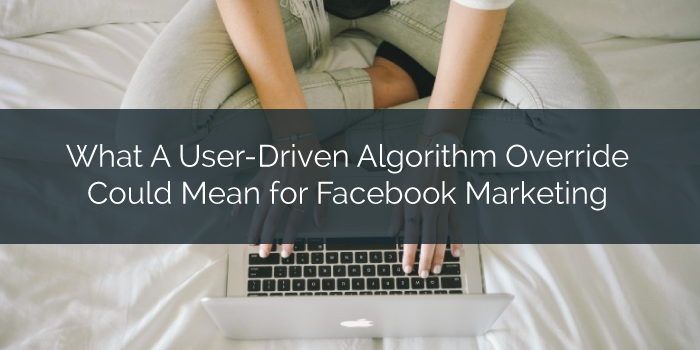
First reported by the Social Times, some Facebook users are beginning to be able to override the news feed algorithm and dictate which friends’ and brand pages’ posts show up at the top of their feed.
Facebook confirmed that they are experimenting with this new feature as part of their never ending quest to deliver high quality content in order to keep and attract even more of users’ online time.
 [Social Times]
[Social Times]
While it’s currently a small test, there are a number of possibilities in how this plays out. Here are few ways I can see this going: 1) Most dramatically, this could mark the beginning of the end of the seemingly irreversible decline of organic reach. The current algorithm may be undervaluing fans’ relationships with brand pages and the override will be able to fix that. 2) Facebook users could use this feature to “teach” their news feed faster than the algorithm could. If for example, a friend shares some cool content from a new brand and the user really likes it, they could tell Facebook that they want to see that brand’s content right then and there, rather than having to continually engage with the brand over time while the algorithm learns. 3) It could be used to help Facebook surface better content for “lurkers” — the large number of people who spend a lot of time on Facebook, but don’t “engage” with any content — they just see what’s going on as they scroll through the feed. Because they don’t interact (like, comment, click, or post) much, they are the hardest for the algorithm to surface the optimal content. With this, lurkers can explicitly select what content they want to see.
Of course, this is very speculative. Nobody knows exactly how this will all play out, but there are a lot of possibilities and its worthwhile for social marketers to think about now.
No matter what, this change makes loyal and engaged fans more important than ever. It will separate the true fans from the rest. Assuming your fans’ loyalty distribution resembles a bell curve, it’s likely that just the front of the curve (the most loyal) will opt-in to force your posts, along with their best friends’ posts, to the top of their feeds.
With that in mind here are a five things to think about in preparation for a possibly larger rollout. (Even if this change doesn’t get all the way there, these steps are still generally useful.)
1. The first thing social marketers must understand about Facebook’s algorithm-related changes is that the first rule of social marketing always remains: great content always wins. Without great content, nothing else matters. Timing, distribution strategies, targeting, etc. are all secondary.
2. Focus on quality over quantity. Indicating that you want to see every post from a friend or brand at or near the top of your newsfeed is quite the commitment in the social world. Brands that are hit-or-miss aren’t going to earn that commitment. But if every time you post, it’s high quality content, your fans will respond and want to see it all.
3. Create owned social content that is targeted at your already engaged audience, rather than new customers or the passive back-of-the-bell-curve fans. Moving the big part of the bell curve forward will have more results in getting fans to select your brand as “must-see” posts, rather than trying to get the back of the bell curve to move all the way to the front. It’s a nudge, rather than a shove.

Your owned social content strategy should be different from your paid social content strategy, anyways. Existing fans are most likely to see the content of owned posts, whereas you can target paid posts to anyone. Since you know who you will be reaching with paid posts, content and targeting must go hand-in-hand. Trying to reach a new demographic or new geographic area? Make content specifically for that group. Trying to get existing customers to make repeat purchases? Make sure your messaging drives the benefits of loyalty home.
With this potential change, create content that gives your existing fans a reason to choose your brand — to want to never miss a post.
4. Influencer identification will have another signal. Because users will also have the option to select friends whose posts they don’t want to miss, Facebook will have another layer of influencer data. Brands will be able to use that data to run effective small-scale influencer campaigns.
Let’s say that a lot of Sarah’s friends selected her as “must-see.” They’re basically telling Facebook that she is an influencer. They want to see what she has to say. That is hugely valuable information for brands that want to reach Sarah’s friends and people like them.
5. When the time comes, ask. (Ok, this one doesn’t apply if Facebook never rolls out this change, but it is important.) If you’re a gmail user, when gmail decided to divide the inbox into categories (primary, social, promotion, etc.), you probably got all sorts of emails that told you to mark the sender as “primary” so that you don’t miss it, even though it was a promotion. Well, this is the same thing.
At the very least, this news feed test shows that Facebook isn’t committed to absolutely dictating what content is surfaced and where on the news feed with its algorithm. That is good news for the marketing world.
This article was syndicated from Business 2 Community: Facebook Testing User-Driven Algorithm Override
More Digital & Social articles from Business 2 Community:




